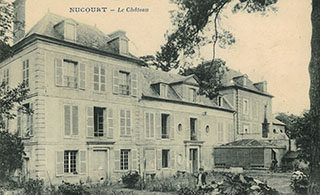Prochain point : lat="49.163" lon="1.84381"

The château
Part of a vast fief
A château remodelled in the nineteenth century...
The manor house was originally in the hamlet of Hardeville. The lord of the manor also owned the adjoining chapel, the parkland, the area of Camp de César, the mill and several other plots of land. It was owned by Pierre de Granville, followed by the Boulainvillers family in the sixteenth century, before being passed on to the Blondel de Joigny family in the seventeenth century. It was then bought by the Monthiers family in the eighteenth century. In 1832, on the death of his wife, Jacques Monthiers had to divide his property among his children. The fief was dismantled, the land sold off individually, the park was divided up and the château was remodelled. Set in a vast park, the château comprises the main rectangular two-storey building, flanked by two pavilions. The style of the architecture is classical, as seen by the cut stone, symmetrical windows, large dormer windows and high roo. The west facade was redesigned in a neo-Gothic style in the nineteenth century.
... Belonging to the Monthiers family
Count Jacques Monthiers (1753-1837) was a lieutenant general of the Bailiwick of Pontoise. Representing the King's authority, the bailiff was in charge of administering justice and controlling the local administration. From the sixteenth century, the role became honorific; the bailiff’s power was then divided between the Lieutenant General and the other officers. During the Revolution, Jacques Monthiers became the first mayor of Nucourt. Oral tradition has it that in 1792 he recovered the body of Sister Marie of the Incarnation, founder of the Carmelite order, who died in 1618. He left Pontoise, concealing the body, and deposited it in the chapel of Nucourt. In 1793, it was found by the revolutionaries and buried in the cemetery. On May 7, 1822, the body was returned to the Carmel of Pontoise.





